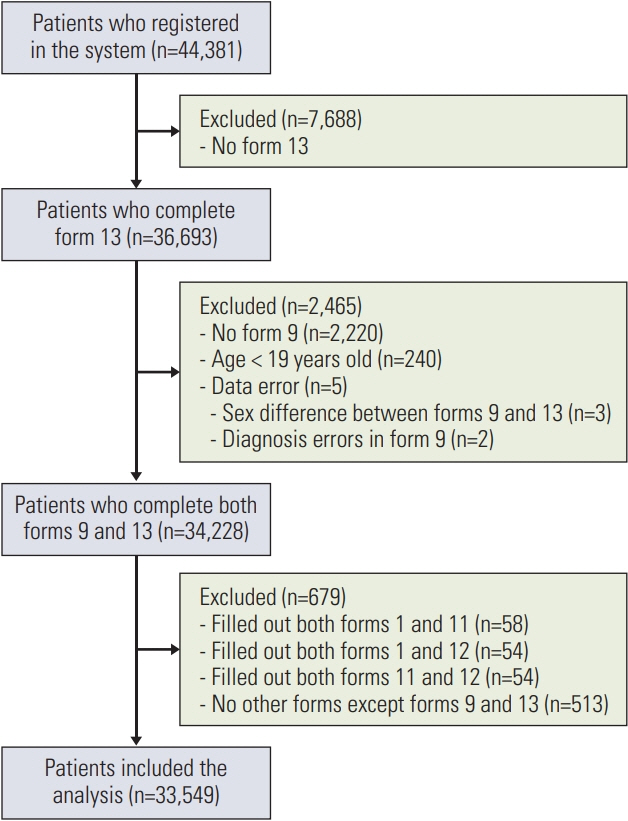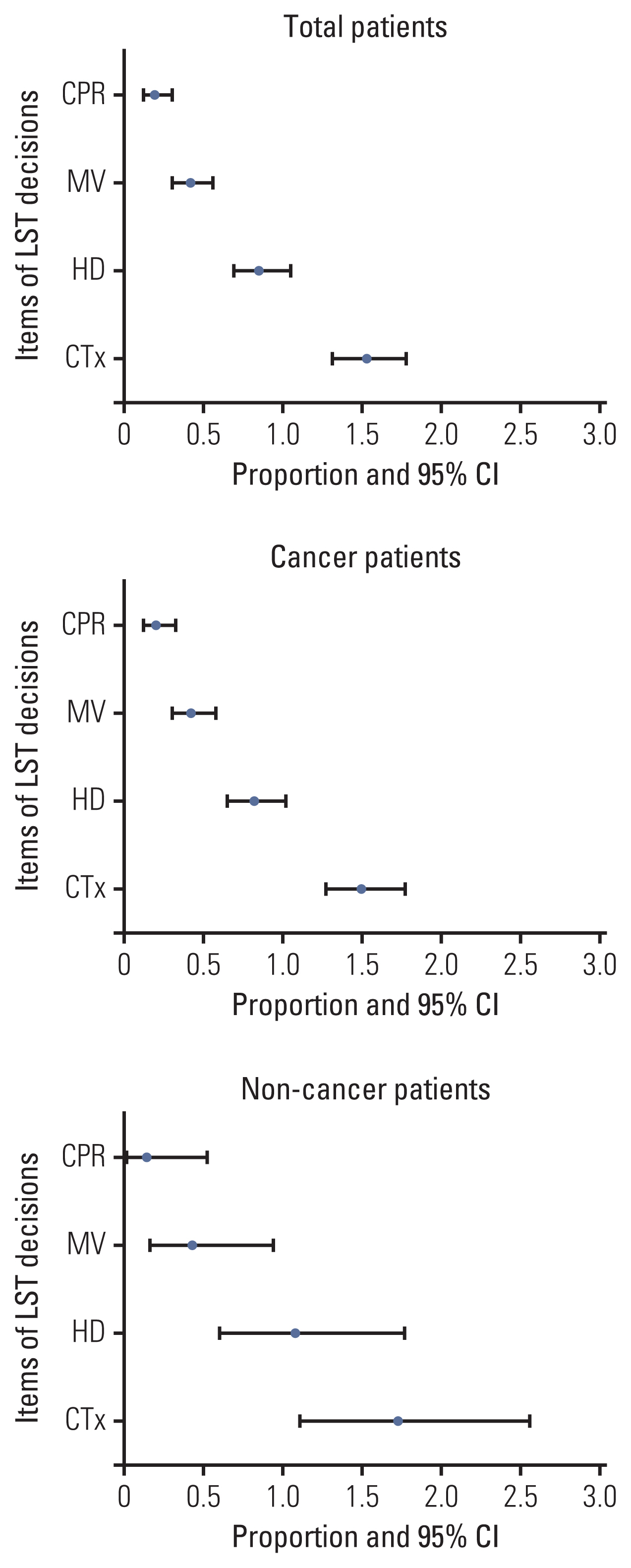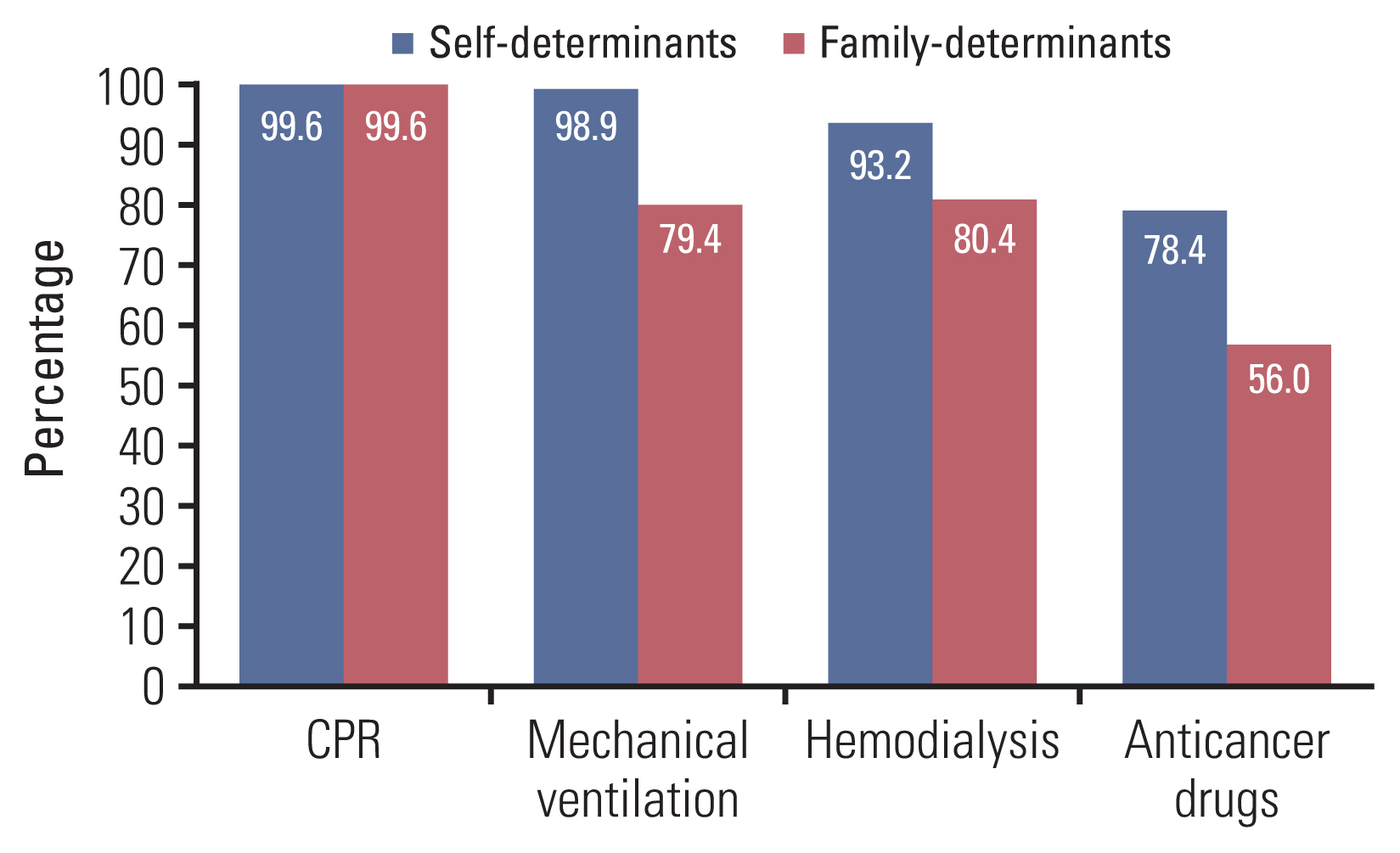Cancer Res Treat.
2021 Oct;53(4):897-907. 10.4143/crt.2021.327.
The Situation of Life-Sustaining Treatment One Year after Enforcement of the Act on Decisions on Life-Sustaining Treatment for Patients at the End-of-Life in Korea: Data of National Agency for Management of Life-Sustaining Treatment
- Affiliations
-
- 1Division of Hematology and Oncology, Department of Internal Medicine, National Medical Center, Seoul, Korea
- 2Department of Preventive Medicine, Ulsan University College of Medicine, Seoul, Korea
- 3Division of Hematology and Oncology, Department of Internal Medicine, Chungnam National University Sejong Hospital, Chungnam National University College of Medicine, Sejong, Korea
- 4Division of Hematology and Oncology, Department of Internal Medicine, Kyung Hee University College of Medicine, Seoul, Korea
- 5Division of Hematology and Oncology, Department of Internal Medicine, Hanyang University College of Medicine, Seoul, Korea
- 6Division of Hematology and Medical Oncology, Department of Internal Medicine, Seoul National University Bundang Hospital, Seoul National University College of Medicine, Seongnam, Korea
- 7Korea National Institute for Bioethics Policy, Seoul, Korea
- 8Division of Hematology and Oncology, Department of Internal Medicine, Chungnam National University Hospital, Chungnam National University College of Medicine, Daejeon, Korea
- KMID: 2521566
- DOI: http://doi.org/10.4143/crt.2021.327
Abstract
- Purpose
The “Act on Hospice and Palliative Care and Decisions on Life-Sustaining Treatment for Patients at the End-of-Life” was enacted on February 3, 2016 and went into effect on February 4, 2018 in Korea. This study reviewed the first year of determination to life-sustaining treatment (LST) through data analysis of the National Agency for Management of Life-Sustaining Treatment.
Materials and Methods
The National Agency for Management of LST provided data between February 4, 2018 and January 31, 2019 anonymously from 33,549 patients. According to the forms patients were defined as either elf-determinants or family-determinants.
Results
The median age of the patient was 73 and the majority was male (59.9%). Cancer patients were 59% and self-determinants were 32.1%. Cancer patients had a higher rate of self-determinants than non-cancer (47.3% vs. 10.1%). Plan for hospice service was high in cancer patients among self-determinants (81.0% vs. 37.5%, p < 0.001). In comparison to family-determinants, self-determinants were younger (median age, 67 years vs. 75 years; p < 0.001) and had more cancer diagnosis (87.1% vs. 45.9%, p < 0.001). Decision of withholding or withdrawing of LSTs in cancer patients was higher than non-cancer patients in four items.
Conclusion
Cancer patients had a higher rate in self-determination and withholding or withdrawing of LSTs than non-cancer patients. Continued revision of the law and education of the public will be able to promote withdrawing or withholding the futile LSTs in patients at end-of-life. Further study following the revision of the law should be evaluated to change of end-of-life care.
Figure
Cited by 3 articles
-
The Law Changes Behaviors: Is It Just Enough?
Dae Ho Lee
Cancer Res Treat. 2021;53(4):895-896. doi: 10.4143/crt.2021.1025.Will implementation of the Life-Sustaining Treatment Decisions Act reduce the incidence of cardiopulmonary resuscitation?
In-Ae Song
Acute Crit Care. 2022;37(2):256-257. doi: 10.4266/acc.2022.00668.Recent Trends in the Withdrawal of Life-Sustaining Treatment in Patients with Acute Cerebrovascular Disease : 2017–2021
Seung Hwan Kim, Ji Hwan Jang, Young Zoon Kim, Kyu Hong Kim, Taek Min Nam
J Korean Neurosurg Soc. 2024;67(1):73-83. doi: 10.3340/jkns.2023.0074.
Reference
-
References
1. Heo DS. Overview and current issues. Korean J Med. 2009; 77(Suppl 4):S1026–34.2. Koh Y, Heo D, Yun YH, Moon JL, Park HW, Choung JT, et al. Characteristics and issues of guideline to withdrawal of a life-sustaining therapy. J Korean Med Assoc. 2011; 54:747–57.3. Heo DS. Patient autonomy and advance directives in Korea. J Korean Med Assoc. 2009; 52:865–70.
Article4. Oh DY, Kim JH, Kim DW, Im SA, Kim TY, Heo DS, et al. CPR or DNR? End-of-life decision in Korea cancer patients: a single center’s experience. Support Care Cancer. 2006; 14:103–8.5. Yun YH, Lee CG, Kim SY, Lee SW, Heo DS, Kim JS, et al. The attitudes of cancer patients and their families toward the disclosure of terminal illness. J Clin Oncol. 2004; 22:307–14.
Article6. Kim DY, Lee KE, Nam EM, Lee HR, Lee KW, Kim JH, et al. Do-not-resuscitate orders for terminal patients with cancer in teaching hospitals of Korea. J Palliat Med. 2007; 10:1153–8.
Article7. Lee JK, Keam B, An AR, Kim TM, Lee SH, Kim DW, et al. Surrogate decision-making in Korean patients with advanced cancer: a longitudinal study. Support Care Cancer. 2013; 21:183–90.
Article8. Supreme Court Decision 2002Do995 decided Jun 24, 2004[Internet]. Seoul: Supreme Court of Korea;2002. [cited 2021 Feb 17]. Available from: https://glaw.scourt.go.kr/ .9. Supreme Court Decision 2009Da17417 decided May 21, 2009[Internet]. Seoul: Supreme Court of Korea;2009. [cited 2021 Feb 17]. Available from: https://glaw.scourt.go.kr/ .10. National Law Information Center. Act on Decisions on Life-Sustaining Treatment for Patients in Hospice and Palliative Care or the End-of-life [Internet]. Sejong: Korea Ministry of Government Legislation;2016. [cited 2021 Feb 17] Available from: https://law.go.kr .11. Vital Statistics Division, Statistics Korea. Shin HY, Kim J, Lee S, Park MS, Park S, et al. Cause-of-death statistics in 2018 in the Republic of Korea. J Korean Med Assoc. 2020; 63:286–97.
Article12. Kong BH, An HJ, Kim HS, Ha SY, Kim IK, Lee JE, et al. Experience of advance directives in a hospice center. J Korean Med Sci. 2015; 30:151–4.
Article13. Hong JH, Kwon JH, Kim IK, Ko JH, Kang YJ, Kim HK. Adopting advance directives reinforces patient participation in end-of-life care discussion. Cancer Res Treat. 2016; 48:753–8.
Article14. Kim JS, Yoo SH, Choi W, Kim Y, Hong J, Kim MS, et al. Implication of the Life-Sustaining Treatment Decisions Act on End-of-Life Care for Korean Terminal Patients. Cancer Res Treat. 2020; 52:917–24.
Article15. Heo DS. End-of-life decision in Korea. J Korean Med Assoc. 2008; 51:524–9.
Article16. Oh DY, Kim JE, Lee CH, Lim JS, Jung KH, Heo DS, et al. Discrepancies among patients, family members, and physicians in Korea in terms of values regarding the withholding of treatment from patients with terminal malignancies. Cancer. 2004; 100:1961–6.
Article17. Amblas-Novellas J, Murray SA, Espaulella J, Martori JC, Oller R, Martinez-Munoz M, et al. Identifying patients with advanced chronic conditions for a progressive palliative care approach: a cross-sectional study of prognostic indicators related to end-of-life trajectories. BMJ Open. 2016; 6:e012340.
Article18. National Law Information Center. Act on Hospice and Palliative Care and Decisions on Life-Sustaining Treatment for Patients at the End-of-life [Internet]. Sejong: Korea Ministry of Government Legislation;2018. [cited 2021 Feb 28]. Available from: https://law.go.kr .19. Wiegand D. In their own time: the family experience during the process of withdrawal of life-sustaining therapy. J Palliat Med. 2008; 11:1115–21.
Article20. Monthly statistics [Internet]. Seoul: National Agency for Management of Life-sustaining Treatment;2020. [cited 2020 Dec 17]. Available from: https://www.lst.go.kr/comm/monthlyStatistics.do .
- Full Text Links
- Actions
-
Cited
- CITED
-
- Close
- Share
- Similar articles
-
- Hemodialysis as a life-sustaining treatment at the end of life
- Well-Dying: Assisted Justice Act as a Dignified and Happy ‘Right to Self-Determination’
- Trends in Nursing Research on Life-Sustaining Treatment in South Korea after the Enforcement of the Act on Decisions on Life-Sustaining Treatment
- Implementation of Antimicrobial Stewardship Programs in End-of-Life Care
- The Impact of Withdrawing or Withholding of Life-Sustaining Treatment: A Nationwide Case-Control Study Based on Medical Cost Analysis





